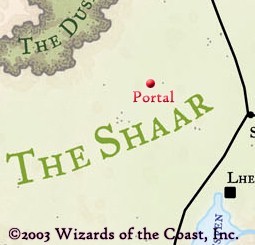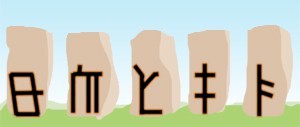Perilous Gateways
Portals of the Written Word
By Robert Wiese
Great Runes
 In ages long past, elven nations established themselves across Faerûn. From Illefarn, which occupied what is now the Silver Marches and the North, to Ilythiir south of the Lake of Steam, these great nations brought culture to the lands now settled by all races. Dwarves established their nations in the mountains and gnomes traded between the two. All this came to an end over the three thousand years of the elven Crown Wars, and thus way was made for humanity to develop.
In ages long past, elven nations established themselves across Faerûn. From Illefarn, which occupied what is now the Silver Marches and the North, to Ilythiir south of the Lake of Steam, these great nations brought culture to the lands now settled by all races. Dwarves established their nations in the mountains and gnomes traded between the two. All this came to an end over the three thousand years of the elven Crown Wars, and thus way was made for humanity to develop.
During that long-ago time of elven empires, the elves quickly developed skill in magic and taught that to the other races. Portals were already known in the world, since the elves and dwarves had used them to migrate here from other worlds. As the Ilythiiri slipped into corruption following their exposure to the goddess Araushnee, they gathered an alliance of nearby elves and some dwarves and talked the group into creating a series of huge portals to the Outer Planes so that all elves could gain wisdom and knowledge by study. Since the elves were even more arrogant then than they are now, none saw the danger.
The dwarves created a truly remarkable set of standing stones in the plains of what is now the Shaar (though it was mostly forested at that time). Each of the five great stones is 50 feet tall and about 25 feet wide and deep. Each is a pale brownish color, almost white, with a dark-colored Dethek run embedded into the stone. The runes are so large that a man could walk through a line of one of them. From left to right, the Dethek runes are (from Forgotten Realms Campaign Setting page 86) top row 10th from left, bottom row 13th from left, bottom row 3rd from left, top row 14th from left, and top row last rune on the right. (See the illustration for a visual aid.)
 The stones are crafted such that there is a sheet of metal 1 foot thick behind the pale brownish parts, but not behind the dark-colored runes. Into the stones themselves the Ilythiiri elves created their portals. The portals were supposed to go to benign planes such as Arvandor, the House of Nature, and the House of Knowledge. However, the Ilythiiri secretly betrayed this agreement and created portals to fell places. From left to right, the portals allow travel to the following planes:
The stones are crafted such that there is a sheet of metal 1 foot thick behind the pale brownish parts, but not behind the dark-colored runes. Into the stones themselves the Ilythiiri elves created their portals. The portals were supposed to go to benign planes such as Arvandor, the House of Nature, and the House of Knowledge. However, the Ilythiiri secretly betrayed this agreement and created portals to fell places. From left to right, the portals allow travel to the following planes:
- The Abyss
- Fury's Heart
- The Demonweb Pits
- The Nine Hells
- The Plane of Shadow
From these places the Ilythiiri hoped to gain power over their elven kin. Since the Crown Wars began just after the completion of the portals, it is unknown whether the gateways were of any use to their creators.
The dwarves believed that this partnership with the elves would bring them greater knowledge of magic, for that is what the Ilythiiri promised. However, the knowledge that the Ilythiiri shared made the dwarves uncomfortable, and they rejected it. This might be one part of why drow and dwarves are still implacable enemies.
The Great Rune portals are particularly difficult to access, since they are inside solid stone. The Ilythiiri designed them this way so that only powerful arcane spellcasters could open the pathways to the Outer Planes. Activating the portals requires only a prayer to Araushnee (not Lolth) and that the person speak the name of the plane to which the portal is keyed. Reaching the portals requires the casting of a passwall spell. This spell cannot open a path through the metal-protected parts of the Great Runes, but it can open up the areas of the letters. The user activates the portal and walks through the letters where they have been temporarily removed.
The Great Rune portals are one-way portals. The Ilythiiri did not have time to create return portals. Thus, anyone using them should provide his or her own way back.
The stones have lasted through the centuries, with the secrets of their usage passed from mother to daughter in drow houses deep in the Underdark. It is not known how many drow can use the portals in the stones, and indeed few on the surface know they are there at all.
Most folk of the Shaar avoid the strange stones, fearing they represent some fell magic. No magic has ever been seen from them, or because of them, but the tribes of nomads prefer not to take unnecessary risks with things they do not understand. The dwarves of the Great Rift see the stones as a sort of holy place, recognizing the ancient craftsmanship of their ancestors. The dwarves use them as a meeting point sometimes, or as a destination of holy pilgrimages when some priest feels the need to seek Moradin's will in a holy place. They do not know the true nature of the stones.
How to Incorporate the Great Runes Into Your Campaign
- A wizard, in seeking a different portal in the Shaar, has found the portals in the Great Runes. Using magic, he (or she) has determined their destinations and how to activate them, but not yet how to reach them. He wants the PCs to figure out how to use the portals and to explore what is on the other side. He prefers not to reveal much about the portals themselves, including that they are one-way or where they go. (He claims that he cannot see where they go.)
- The Ilythiiri created the third portal to have a direct way to reach their deity. In the eons since they became the drow they have created other ways, but the ancient site still holds interest for some drow. The PCs discover a surface drow group making its way towards the Great Runes and are asked to stop them before the drow victimize nearby commoners.